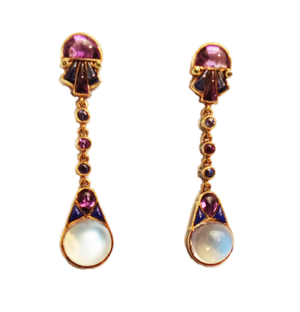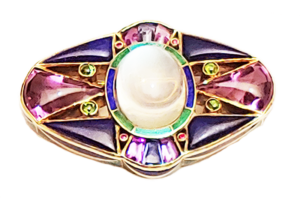The artist Marie Zimmermann was born in 1879 to upper-middle class Swiss immigrant family living in Brooklyn, NY. Zimmermann’s education began at Packer Collegium, a preparatory school promising admission to Vassar, Smith or Wellesley without examination. Zimmermann, however, dropped out of their program before completion, and began studying at the Art Students League in New York City in October of 1897. She left there as well, and after seeing an advertisement, enrolled in several classes in metals and jewelry at the newly founded Pratt Institute. At Pratt she studied a range of materials, from bronze and copper to jewelry, all of which she continued to work in throughout her life.
In 1901, Zimmermann joined the National Arts Club, which attempted to link art lovers and art workers. She acquired a studio there in 1910, and filled it with furniture of her own design. In the same year began listing her occupation as an artist. She first displayed her work in 1916 in two separate exhibitions; her “groups of copper” exhibited at Herter Looms in Manhattan and her “works of art” at Ehrich Galleries. She was featured in an article in the New York Evening Sun entitled “This Being a Feminist Age, the Village Smithy Is a Studio and the Smith a Comely Young Woman: Her Apron is Blue Gingham, Her Forge a Gas Flame and Her Hammers and Tongs Are Small and Bright.”
The 1920’s were a busy time for Zimmermann. She employed a staff of several workers and contractors to execute the completion of her designs. She often cast bronze with Riccardo Bertelli at the Roman Bronze Work in Greenpoint, Brooklyn and employing a blacksmith to produce works in wrought iron garden ornaments beginning in 1918. “I am the brains and they are the hands” Zimmermann said her employees.
One of Zimmermann’s largest commissions came from Grace Selly Groesbeck who employed her to create many lighting fixtures and decorative elements for her newly constructed country house. Another important commission for Zimmermann was a low centerpiece bowl and candlesticks for the wedding of the heiress Lolita Armour. Ms. Armour had been heavily followed in the press, and Zimmermann’s pieces were featured in at least one article as a fortuitous result of the coverage of the wedding.
 Zimmermann created jewelry in two distinct styles; her design-oriented pieces with enamel and other decorative elements playing a major role and her works focused on the opulence of large and beautiful stones. Her pieces show a strong Egyptian and Classical influence, executed in an Egyptian palette of blue red and green, or including classical cameos as the main jewels of the pieces. In addition Zimmermann created several unique and non-traditional engagement rings for her clients including a large indicolite tourmaline ring with an enameled lotus and leaf setting for Rowena Stewart Paton. Zimmermann’s jewelry is quite unique. Her pieces are opulent and highly original. Her choices of stones and colors is brilliant, and combined with rich enamels, the pieces are often spectacular. Unfortunately, they are also quite rare.
Zimmermann created jewelry in two distinct styles; her design-oriented pieces with enamel and other decorative elements playing a major role and her works focused on the opulence of large and beautiful stones. Her pieces show a strong Egyptian and Classical influence, executed in an Egyptian palette of blue red and green, or including classical cameos as the main jewels of the pieces. In addition Zimmermann created several unique and non-traditional engagement rings for her clients including a large indicolite tourmaline ring with an enameled lotus and leaf setting for Rowena Stewart Paton. Zimmermann’s jewelry is quite unique. Her pieces are opulent and highly original. Her choices of stones and colors is brilliant, and combined with rich enamels, the pieces are often spectacular. Unfortunately, they are also quite rare.
In roughly 1927, Zimmermann began her relationship with her life-time partner Ruth Allen, an actress in stage production and silent movies. Ruth Allen lived with Zimmermann until Allen’s death in 1969.
During the difficult economic times of the 1930’s, Zimmermann was forced to limit her production of many luxury goods. One of her main sources of income during this period were memorial project,s including a Gothic-style memorial shrine or columbarium made for Rudolf A. Metz between 1934 and 1935, and a bronze tree with two markers commissioned for Leopold Fredrick in 1937. Zimmermann joked with her friends that she was “just a craftswoman who, as a friend of mine once said, makes everything from tiaras to tombstones.”
Zimmermann also showed her business acumen in the 30’s by advertising a silver-plating service for wealthy family who were forced to reduce their staff. She coated their pieces in rhodium to eliminate the need for polishing and included on each a sticker with the text “Veiled in Rhodium, by Marie Zimmermann.”
While the Great Depression forced Zimmermann to limit the amount of jewelry she produced, she did not stop. Most of her pieces during this time were commissions with the stones usually provided by the client. In addition to those pieces, Zimmermann experimented with semi-precious stones, creating flexible choker necklaces similar to Cartier’s “Tutti Frutti” pieces.
In the 1930’s Zimmermann also produced an unusual pair of aluminum chalices for a wealthyPittsburg family, likely one involved in the aluminum industry as aluminum was at the time rather uncommon and more expensive than it is today without considering inflation.
Zimmermann exhibited a few times around this time. Her pieces were shown during a very short show at John G. Hamilton Gallery in early May 1934 and Gibbs Memorial Art Gallery inCharleston, South Carolina featured her work in a one-woman show in March 1935. Due to several deaths in the family, Zimmermann spent the next few years without exhibiting, and left her studio and apartment at the National Arts Club. Her last exhibition was 3-woman show atFaulkner Memorial Art Gallery in 1939. The exhibition was a huge flop: no profit was made. Zimmermann took this as a sign to retire, and closed her workshop soon after.
Over the remaining years of her life, Zimmermann gardened, hunted and read actively. She kept most of her remaining stock of metalwork, but gifted many of the jewelry she made to visiting friends. She died in the year 1972. Her pieces can be found in many museums and institutions including the Metropolitan Museum of Art, Museum of Fine Arts-Boston, the Art Institute of Chicago and the Carnegie Museum of Art.
Showing all 2 results



